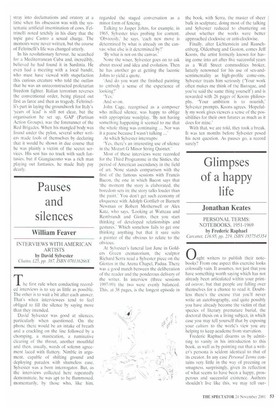Pauses and silences
William Feaver
INTERVIEWS WITH AMERICAN ARTISTS by David Sylvester Chano,125, pp. 387. ISBN 070116266X The first rule when conducting recorded interviews is to say as little as possible. The other is to wait a bit after each answer. That's when interviewees tend to feel obliged to fill the silence by saying more than they intended.
David Sylvester was good at silences, particularly when questioned. On the phone there would be an intake of breath and a crackling on the line followed by a chomping, a mastication, a ruminative clearing of the throat, another mouthful and then, usually, words of solemn agreement laced with flattery. Nimble in argument, capable of shifting ground and deploying paradox with shameless ease, Sylvester was a born interrogator. But, as the interviews collected here repeatedly demonstrate, he was apt to be flummoxed, momentarily, by those who, like him, regarded the staged conversation as a minor form of fencing.
Talking to Jasper Johns, for example, in 1965, Sylvester tries probing for content. 'Obviously,' he says, 'each new move is determined by what is already on the canvas; what else is it determined by?'
'By what is not on the canvas.'
None the wiser, Sylvester goes on to ask about mood and idea and evolution. Then he has another go at getting the laconic Johns to yield a quote.
'And do you want the finished painting to embody a sense of the experience of looking?'
'Yes..
And so on.
John Cage, recognised as a composer who milked silence, was happy to oblige with appropriate wordplay. 'By not having something happening it seemed to me that the whole thing was continuing ... Nor was it a pause because I wasn't talking ...'
At which Sylvester interrupts: 'Yes, there's an interesting use of silence in the Mozart G Minor String Quintet.'
Most of these interviews were recorded for the Third Programme in the Sixties, the period of American ascendancy in the field of art. None stands comparison with the first of the famous sessions with Francis Bacon, the one in which Bacon says that 'the moment the story is elaborated, the boredom sets in; the story talks louder than the paint.' You don't get such economy of eloquence with Adolph Gottlieb or Barnett Newman or Robert Motherwell or Alex Katz, who says, 'Looking at Watteau and Rembrandt and Giotto, then you start thinking of developed relationships and gestures.' Which somehow fails to get one thinking anything but that it sure suits a painter of the obvious to relate to the obvious.
At Sylvester's funeral last June in Golders Green crematorium, the sculptor Richard Serra read a Sylvester piece on the Giottos in the Arena Chapel, Padua. There was a good match between the deliberation of the reader and the ponderous delivery of the writer. In interview (three sessions 1997-99) the two were evenly balanced. This, at 38 pages, is the longest episode in the book, with Serra, the master of sheer bulk in sculpture, doing most of the talking and Sylvester reduced to chuntering on about whether the works were better approached clockwise or anti-clockwise.
Finally, after Lichtenstein and Rauschenberg, Oldenburg and Guston, comes Jeff Koons, the artist formerly known for having come into art after five successful years as a Wall Street commodities broker, latterly renowned for his use of sex-andsentimentality as high-profile come-ons. Sylvester treats him seriously ('Your work often makes me think of the Baroque, and you've said the same thing yourself) and is rewarded with 26 pages of Koons philosophy. 'Your ambition is to nourish,' Sylvester prompts. Koons agrees. 'Hopefully my work gives viewers a sense of the possibilities for their own futures as much as it does for mine.'
With that, we are told, they took a break. It was ten months before Sylvester posed his next question. As pauses go, a record surely?


















































































 Previous page
Previous page